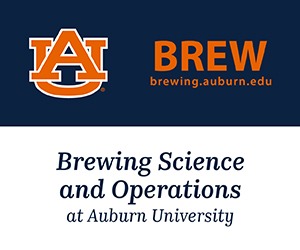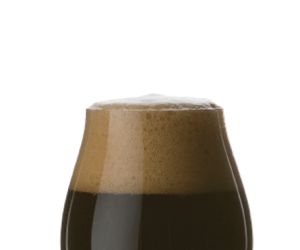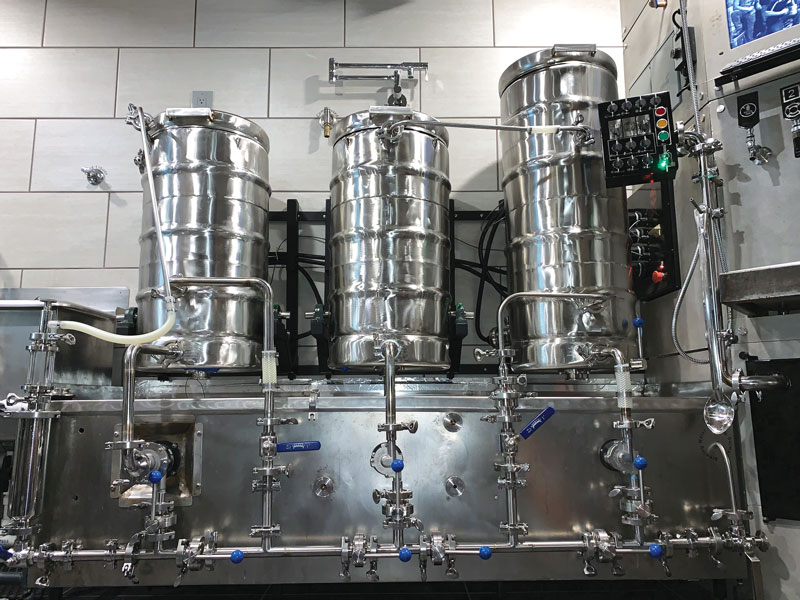PA Alers 10th Anniversary Russian Imperial Stout
PA Alers 10th Anniversary Russian Imperial Stout
(5 gallons/19 L, all-grain)
OG = 1.115 FG = 1.035
IBU = 84 SRM = 45 ABV = 12%
Ingredients
13 lbs. (5.9 kg) Maris Otter pale ale malt (3 °L)
3.4 lbs. (1.5 kg) light Munich malt (10 °L)
1.1 lbs. (0.51 kg) wheat malt (2 °L)
9 oz. (0.26 kg) Weyermann Carafa® III malt (525 °L)
9 oz. (0.26 kg) chocolate malt (350 °L)
9 oz. (0.26 kg) roasted barley (300 °L)
9 oz. (0.26 kg) Special B malt (135 °L)
2.4 lbs. (1.1 kg) Muntons extra light dried malt extract (3 °L)
20.7 AAU Galena hops (60 min.) (1.8 oz./51 g at 11.5% alpha acid)
19 AAU Simcoe® hops (10 min.) (1.5 oz./42 g at 12.7% alpha acid)
Whirlfloc (15 min.)
Yeast nutrient (15 min.)
White Labs WLP007 (Dry English Ale) yeast (1.5 L/1.6 qt. yeast starter)
White Labs WLP099 (Super High Gravity Ale) yeast (1L/1 qt. yeast starter)
¾ Cup corn sugar (for priming)
Step by Step
One week before brew day, get a WLP007 yeast starter going. When starter activity slows, decant the spent wort and add fresh wort.On brew day, mill the grains and dough-in with 28 quarts (26.5 L) hot water, targeting a mash at 154 °F (68 °C). Hold until enzymatic conversion is complete. If your system allows, raise the mash temperature to 168 °F (76 °C) and recirculate the wort until clear. Sparge with 170 °F (77 °C) water to collect 6.5 gallons (25 L) of wort. Take a specific gravity reading and add the dried malt extract until the specific gravity is 1.088. Boil for 90 minutes, adding the Galena and Simcoe® hops at 60 and 10 minutes respectively. Add Whirlfloc and yeast nutrient with 15 minutes remaining in boil. Chill the wort to 70 °F (21 °C), aerate, and add WLP007 starter (decanting the spent wort first). When fermentation slows, take a gravity reading and add the WLP099 starter (if needed) to achieve a final specific gravity of 1.035. Keg or bottle carbonate, aiming for a carbonation level of 2.0–2.2 volumes of CO2. Once carbonated, condition at cellar temperature for several months. Flavor should peak at about one year and remain there for at least another year.
10th Anniversary Russian Imperial Stout
(5 gallons/19 L, extract with grains)
OG = 1.115 FG = 1.035
IBU = 84 SRM = 45 ABV = 12%
Ingredients
10 lbs. (4.5 kg) Muntons extra light dried malt extract (3 °L)
1.7 lbs. (0.8 kg) table sugar (sucrose) (0 °L)
9 oz. (0.26 kg) Weyermann Carafa® III malt (525 °L)
9 oz. (0.26 kg) chocolate malt (350 °L)
9 oz. (0.26 kg) roasted barley (300 °L)
9 oz. (0.26 kg) Special B malt (135 °L)
20.7 AAU Galena hops (60 min.) (1.8 oz./51 g at 11.5% alpha acid)
19 AAU Simcoe® hops (10 min.) (1.5 oz./42 g at 12.7% alpha acid)
Whirlfloc (15 min.)
Yeast nutrient (15 min.)
White Labs WLP007 (Dry English Ale) yeast (1.5 L/1.6 qt. yeast starter)
White Labs WLP099 (Super High Gravity Ale) yeast (1L/1 qt. yeast starter)
3⁄4 Cup corn sugar (for priming)
Step by Step
One week before brew day, get a WLP007 yeast starter going. When starter activity slows, decant the spent wort and add fresh wort.On brew day, crush the grains and place in two steeping bags. Steep the bags at 155 °F (68 °C) in 16 quarts (15 L) of water for 20 minutes. Rinse the grains with 2 quarts (2 L) of 170 °F (77 °C) hot water. Add dried malt extract (DME) and table sugar. Boil for 60 minutes, adding the hops at the specified times. Chill the wort to
70 °F (21 °C) and add water to achieve 5 gallons (19 L) of wort. Aerate the wort and add WLP007 starter (decanting the spent wort first). When fermentation slows, take a gravity reading and add WLP099 starter (if needed) to achieve a final specific gravity of 1.035. Keg or bottle carbonate, aiming for a carbonation level of 2.0–2.2 volumes of CO2. Once carbonated, condition at cellar temperature for several months. Flavor should peak at about one year and remain there for at least another year.
Tips for Success:
Pitching plenty of healthy yeast is paramount for a high gravity brew. When in doubt, pitch more. Be patient with the fermentation and conditioning process. Beer doesn’t have a schedule. For bottle carbonation, pitch fresh yeast at bottling time if the WLP099 wasn’t needed during the brew day. Give the bottles adequate time to carbonate. This beer needs to age, anyway. You’ll thank me later for saving it until its peak. If you would like, try aging this beer in a bourbon barrel. How long to barrel condition is a matter of individual taste. Our club likes a full bourbon flavor, so we age the beer for several months. We don’t worry about temperature. The barrel’s alive, and varying temperatures allow the wood to expand and contract, imparting those wonderful oak and bourbon flavors.
Written by Mark Pasquinelli

The homebrew club PA Alers provide the recipe the club brewed to commemorate their 10th Anniversary.



